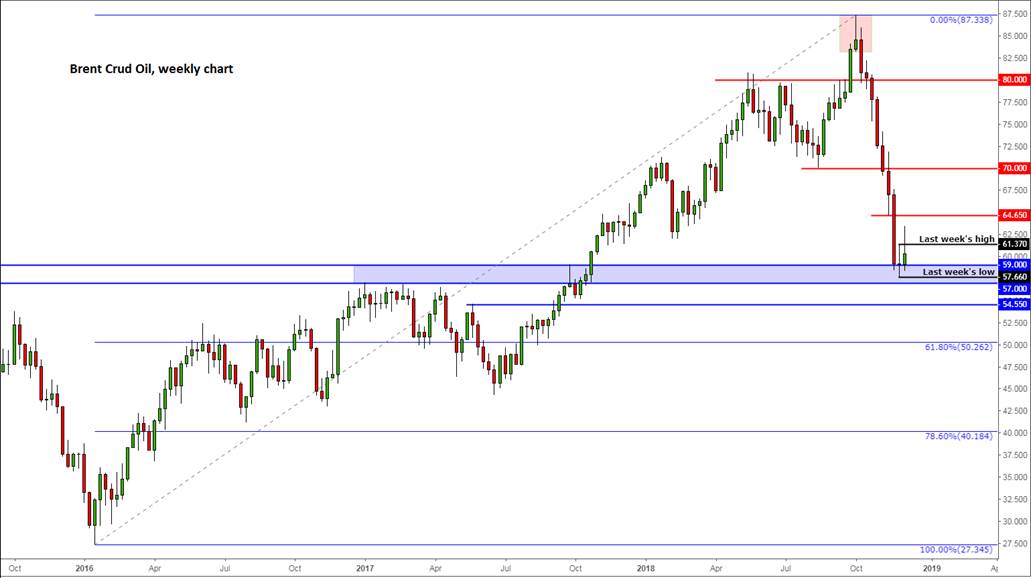The so-called OPEC+ group of oil producers, which includes the traditional players in the oil cartel as well as non-OPEC countries such as Russia, look set to agree on cutting oil production to help shore up prices, defying calls from US President Donald Trump to leave output unchanged and keep prices low. The OPEC is meeting in Vienna today ahead of a summit with oil producers outside of the cartel (i.e. OPEC+) on Friday. Oil prices have fallen sharply nevertheless amid concerns the potential cuts could be lower than expected, with a barrel of Brent oil costing about 4% lower at $59.00.
Judging by the incoming remarks from several OPEC ministers, it is not a question of whether the cartel will decide to cut supplies or not, but by how much. They are fully aware of the risks of another severe supply glut developing if they take no action. OPEC countries simply cannot afford to see another 2014-style slump in oil prices after a near 30% plunge over the past couple of months.
It is understood that Saudi Arabia wants the OPEC to reduce output by around 1 million barrels per day, but this is dependent on how big the supply reduction from Russia will be - if any. The OEPC, already losing market share to the US shale oil producers, will not want Russia to gain further advantage at its expense. If Russia were to cut its production by, say, 250,000 bpd, which is likely in our view, then the total supply reduction from the OPEC+ group could be around 1.3 million bpd.
The problem for the OPEC is that it’s de facto leader, Saudi, is facing significant pressure from the US, its key western ally, not to cut oil production. Yesterday, the US President tweeted: “Hopefully OPEC will be keeping oil flows as is, not restricted. The World does not want to see, or need, higher oil prices!” But just like the US is pursuing its own interests, one cannot expect Saudi to do anything different - even despite the controversy surrounding the killing of journalist Jamal Khashoggi in Istanbul at the Saudi embassy.
So, this might mean a mere conservative cut in crude output – a middle ground that is not too disappointing in the eyes of participants in the oil market, yet not too severe to prompt angry reaction from Washington.
Indeed, oil prices fell sharply on Thursday morning when Al-Falih, Saudi’s energy minister, signalled that the production cut could be less than expected. He said an output cut of 1 million bpd could be sufficient, contradicting his previous assessment of 1.3 million bpd. But, as mentioned, a total of 1.3 million bpd cut could nonetheless be agreed upon from the OPEC+ group.
If the total output cut is indeed around 1.3m bpd, I think Brent oil prices will probably not fall too much further, given the 4% or so drop on Thursday in response to the rumours, with $55 being a potential level where it might bounce from. If the cut is larger than that then prices could certainly bounce back – the extent of which will depend on the size of the cut. And it is probably safe to say that a failure to reach a deal could see Brent oil prices plunge towards the low $50s almost immediately.
Figure 1:
Source: TradingView and FOREX.com. Please note, this product is not available to US clients
Trading leveraged products such as FX, CFDs and Spread Bets carry a high level of risk which means you could lose your capital and is therefore not suitable for all investors. All of this website’s contents and information provided by Fawad Razaqzada elsewhere, such as on telegram and other social channels, including news, opinions, market analyses, trade ideas, trade signals or other information are solely provided as general market commentary and do not constitute a recommendation or investment advice. Please ensure you fully understand the risks involved by reading our disclaimer, terms and policies.
Recommended Content
Editors’ Picks
EUR/USD edges lower toward 1.0700 post-US PCE

EUR/USD stays under modest bearish pressure but manages to hold above 1.0700 in the American session on Friday. The US Dollar (USD) gathers strength against its rivals after the stronger-than-forecast PCE inflation data, not allowing the pair to gain traction.
GBP/USD retreats to 1.2500 on renewed USD strength

GBP/USD lost its traction and turned negative on the day near 1.2500. Following the stronger-than-expected PCE inflation readings from the US, the USD stays resilient and makes it difficult for the pair to gather recovery momentum.
Gold struggles to hold above $2,350 following US inflation

Gold turned south and declined toward $2,340, erasing a large portion of its daily gains, as the USD benefited from PCE inflation data. The benchmark 10-year US yield, however, stays in negative territory and helps XAU/USD limit its losses.
Bitcoin Weekly Forecast: BTC’s next breakout could propel it to $80,000 Premium

Bitcoin’s recent price consolidation could be nearing its end as technical indicators and on-chain metrics suggest a potential upward breakout. However, this move would not be straightforward and could punish impatient investors.
Week ahead – Hawkish risk as Fed and NFP on tap, Eurozone data eyed too

Fed meets on Wednesday as US inflation stays elevated. Will Friday’s jobs report bring relief or more angst for the markets? Eurozone flash GDP and CPI numbers in focus for the Euro.
